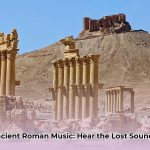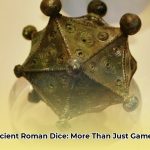Ever wondered what kind of tunes filled the air back in ancient Rome? Forget the thunderous roar of the Colosseum crowds for a moment. Instead, let’s listen to the rich sounds that shaped their world. We’ll explore the instruments they used, from battlefield blares to peaceful temple melodies. How did their music compare to the Greeks, their profound musical mentors? And yes, they even had a water-powered organ! We’ll unravel how that incredible contraption worked. Join us as we dig into why music was so vital to the Roman army and their intricate religious ceremonies, exploring how their borrowing of musical ideas shaped their truly unique sound. Get ready to turn up the volume and journey back in time to experience the vibrant, often surprising, music of the Roman Empire!
The Sounds of the Empire: Exploring Ancient Roman Musical Instruments
Picture yourself amidst the bustling streets of ancient Rome, the crowd’s murmur a constant hum, the gladiatorial games a distant echo. But what about the pervasive melodies? Beyond the dramatic spectacles and chariot races, ancient Rome resonated with a diverse and profoundly integral musical life. This rich tapestry of sounds was deeply woven into their daily existence, from the lowest commoner to the highest emperor. The ruins of Pompeii, for instance, buried under volcanic ash and rock in 79 AD, reveal numerous frescoes, mosaics, and wall paintings depicting people and mythological figures playing musical instruments, highlighting how central music was to Roman life. So, let’s explore some of the fascinating instruments that defined the Roman world’s sonic landscape. Could a single trumpet blast truly organize an entire legion? The answer might surprise you, revealing the profound practical applications and the complex artistic expressions of ancient Roman musical instruments. The Romans learned much from Ancient Greek Music.
Were the Romans Just Copycats, Musically Speaking?
The Romans were undoubtedly adept at cultural adaptation, particularly when it came to music. They extensively adopted and skillfully reinterpreted ideas from the Greeks and Etruscans. Instruments such as the lyre, a stringed instrument somewhat resembling a small harp, and the tibia (which the Greeks called an aulos, a type of double-reed wind instrument similar to an oboe), were directly influenced by Greek design. The tuba, a powerful, long brass horn, originated as an Etruscan instrument.
However, the Romans didn’t merely replicate these designs; they innovated and personalized them. They absorbed these foreign influences and made them distinctly their own, often enhancing their scale and volume to suit the grandiosity of Roman public life. Consider the cithara, or kithara, an instrument that evolved into a larger, more resonant, and louder version of the lyre. This instrument became an essential fixture in Roman society, played by commoners and at high-class functions, providing vibrant tunes at banquets and public gatherings. Roman stories even speak of the cithara being played so beautifully that it would move people to tears, demonstrating its widespread emotional impact. This illustrates that while they borrowed, they also Romanized, enhancing instruments to suit their grand spectacles and specific societal needs.
Instruments of Martial Might: Sonic Warfare and Command
Imagine a Roman battlefield: the clash of swords, the roar of thousands of soldiers. Now, add the piercing blast of the tuba or the deep, resonant call of the cornu – a massive, curved horn encircling the player’s body. These instruments were far from mere entertainment. They served as crucial communication tools for the Roman army, transmitting signals and commands amidst the overwhelming cacophony of battle, ensuring coordinated movements and strategic maneuvers.
Flavius Vegetius Renatus, a Roman writer on military matters, eloquently described their function in “De Re Militari”: “The music of the legion consists of trumpets, cornets and buccinae. The trumpet sounds the charge and the retreat. The cornets are used only to regulate the motions of the colors; the trumpets serve when the soldiers are ordered out to any work without the colors; but in time of action, the trumpets and cornets sound together.” He noted that the classicum, a specific sound of the buccina or horn, was reserved for the commander-in-chief, signifying his authority in military actions or even executions. This sonic discipline effectively transformed music into a precise form of sonic warfare, proving its efficacy in maintaining unit cohesion and executing complex battle strategies across vast distances. An unearthed copper alloy mouthpiece of a cornu at the Roman fort of Vindolanda in northern England, dated to between A.D. 120 and 128, offers tangible evidence of these instruments’ real-world presence in military life.
The cornu, often described as a ‘G’-shaped brass instrument about 3 meters (9.8 feet) long, was braced by a crossbar for the player’s shoulder. Its imposing size and loud sound made it ideal for signaling across large formations. The tuba, a long straight horn typically made of bronze and about four feet in length, produced a sound similar to a modern straight trumpet. Since it had no valves, it could only play notes in the harmonic series, primarily used for clear, unmistakable signals like “charge,” “retreat,” or “change of guard.” Music, therefore, was not merely an art form; it was an indispensable, life-saving element in securing military victories.
Instruments of Ritual, Spectacle, and Daily Life
Music permeated nearly every aspect of Roman life, extending beyond the battlefield to embrace religious festivals, grand public spectacles, and intimate private gatherings.
- Religious Ceremonies: The tympanum, a handheld frame drum similar to a tambourine, provided rhythmic pulsations for exuberant festivals honoring Dionysus (Bacchus to the Romans), often depicted in art dedicated to the god. The sistrum, a metallic rattling instrument with cross-bars and small rings that clanked when shaken, added a mystical ambiance to Roman religious ceremonies, an influence adopted from Egyptian traditions. Music and religion were inseparable, with gods like Apollo (patron of music and dance), Minerva (associated with the aulos flute), and Faunus (often depicted playing pan-pipes) intrinsically linked to musical endeavors. Horace’s ‘Secular Hymn,’ commissioned by Emperor Augustus in 17 BC, was dedicated to Apollo and Diana, illustrating music’s role in formal religious events.
- Public Spectacles: Musical contests were immensely popular. Emperors themselves participated, underscoring the cultural significance of musical prowess. Emperor Nero, notorious for his vanity, passionately pursued a career as a lyre-player and singer. According to the historian Suetonius, Nero would hold monotonous lyre recitals, sometimes locking the audience in the theater, famously stating, “Hidden music counts for nothing.” He even created “victory games” where he would compete and “win” over 1,100 events, often with his bodyguards ominously close by. The hydraulis also played a role in public events and gladiatorial contests, its powerful sound heightening the drama of the arena.
- Private Entertainment & Social Occasions: Music created an engaging atmosphere for Roman social events. Wealthy patricians might have a cithara or lyre played in the background during banquets. The lyre, a smaller and more portable stringed instrument, was often used in educational settings and for private enjoyment. Suetonius noted that Emperor Titus was “not unacquainted with music, but sang and played the harp agreeably and skillfully.” Even Emperor Hadrian was said to boast openly of his flute-playing and singing skills. The pandura, a lute-like instrument with four strings, was rarer but brought out for special occasions. The scabellum, a unique percussion instrument played with the foot, allowed musicians to keep rhythm while their hands were free for other instruments.
- Daily Life & Celebrations: Music accompanied Roman wedding feasts (
deductio), with torch-bearers and flute-players leading the procession, and marriage hymns sung. Funeral processions also featured bands of musicians, sometimes even buffoons and jesters who imitated the deceased, demonstrating music’s role in marking life’s transitions. Clementis Recognitiones (c. A.D. 220) recorded that “Most men abandon themselves at festival time and holy days, and arrange for drinking and parties, and give themselves up wholly to pipes and flutes and different kinds of music and in every respect abandon themselves to drunkenness and indulgence.” This suggests the pervasive and celebratory nature of music. Even the arrival of Cleopatra in Tarsus to meet Marc Antony, as described by Plutarch, featured a perfumed barge with “oars of silver which dipped in time to the music of the flute, accompanied by pipes and lutes.”
The integration of music into grand events and daily rituals suggests its profound importance. Indeed, musical ability was considered a marker of a well-rounded and educated Roman citizen, reflecting music’s esteemed place in their cultural hierarchy and social standing.
The Roman Orchestra: Instruments and Their Roles
| Instrument | Type | Characteristics | Common Use |
|---|---|---|---|
| Tuba | Brass | Long, straight, about 4 ft (1.2m), bronze, fixed pitch. | Military signals (charge, retreat), public announcements, gladiator games. |
| Cornu | Brass | Large, ‘G’-shaped, about 9.8 ft (3m), bronze, carried around the body. | Military signals (troop formation, orders), parades, spectacles. |
| Cithara (Kithara) | String | Larger, louder lyre-like instrument, precise tuning possible. | Banquets, religious ceremonies, theatrical performances, concerts. |
| Lyre | String | Smaller, harp-like, 4-10 strings, wood or tortoise shell. | Educational settings, private entertainment, early Roman history. |
| Tibia (Aulos) | Woodwind | Double-reed pipe (sometimes single), similar to oboe, often paired. | Religious ceremonies, theatrical performances, mood setting. |
| Syrinx (Pan Flute) | Woodwind | Multiple hollow tubes of increasing length, wood/reeds (rarely metal/ivory). | Pastoral settings, everyday life, accessible household instrument. |
| Hydraulis | Keyboard | Water-powered organ with multiple pipes, complex mechanism. | Grand public concerts, gladiatorial arena, demonstrations of wealth/power. |
| Tympanum | Percussion | Handheld frame drum, similar to a tambourine, animal skin head. | Religious festivals (Dionysus), accompanying dance, parties. |
| Sistrum | Percussion | Rattle with metal rings on crossbars, Egyptian origin. | Religious rituals, ceremonial purposes, adding mystical ambiance. |
| Scabellum | Percussion | Foot-operated clapper with cymbals, like an early hi-hat. | Designating rhythm/tempo, accompaniment for dancing. |
| Cymbalum (Cymbala) | Percussion | Small metal disks, played with fingers (like finger cymbals). | Accompaniment for dancers, rhythmic emphasis. |
| Crotalum | Percussion | Castanet-like, pair of concave shells joined by string. | Handheld clicks for accompaniment during dances. |
| Lute (Pandura) | String | Small body, long neck, 3-4 strings, similar to modern guitar. | Special occasions, melodic sounds, portable. |
Unearthing the Sounds
It’s tempting to view Romans primarily as soldiers and master builders, but they were also avid patrons and practitioners of music. They embraced, modified, and created their own distinctive sounds. While only fragments of their musical compositions survive today – scholars admit “No one knows what Roman music sounded like” and lack a complete understanding of their notation system – these remnants offer invaluable insights into their dynamic culture. Efforts to recreate Roman music rely on archaeological remains, historical texts, and artistic depictions. What other musical secrets remain hidden, awaiting discovery, promising to further enrich our understanding of this ancient civilization? Extensive research continues, but current findings unequivocally demonstrate music’s foundational role in Roman identity and societal expression.
How Did Romans Tune Instruments?
The intriguing question of how did Romans tune instruments transports us to a world where music echoed through marble halls and vibrated across battlefields. Imagine attempting to recreate those ancient sounds today! Were their tuning methods as sophisticated as our modern precise systems? Let’s delve into this fascinating, albeit somewhat enigmatic, aspect of ancient Roman musical life.
The Echoes of Greece and Etruria
Crucially, Roman music did not develop in isolation. They readily adopted and skilfully reinterpreted the musical traditions of the Greeks and Etruscans. Consider this a cultural fusion, where they took fundamental elements and infused them with their own distinctive character. These influences undeniably shaped their tuning practices. While definitive documentation on Roman tuning specifics is scarce, parallels with Greek musical theory and archaeological findings provide compelling clues.
Stringed Instruments: Lyres and Kitharas
Stringed instruments such as the lyre and cithara held significant prestige in Roman society. So, how did Romans tune instruments like these? It is highly probable they employed methods similar to the Greeks, meticulously adjusting string tension to achieve desired pitches. Each string would have been carefully tightened or loosened until it resonated with the intended note. The instrument’s bridge also played a critical role, influencing string length and, consequently, the pitch. Without electronic tuners, this process would have demanded an exceptional ear and a thorough understanding of musical intervals, a skill perfected over years of dedicated practice and passed down through generations of musicians.
Wind Instruments: Tibias and Tubas
Now, let’s consider the tibia, a double-pipe instrument analogous to the Greek aulos. How did Romans tune instruments of this type? Tuning a tibia likely involved manipulating the reeds and the effective length of the pipes. Adjusting the reed’s position or selecting different reeds would alter the instrument’s sound. Some tibias might have featured adjustable sleeves or holes that could be opened or closed to fine-tune the pitch, similar to the mechanism of a modern recorder.
The tuba, a long bronze trumpet, presented a different challenge. Its fundamental tuning was largely fixed, determined by the instrument’s precise physical dimensions. However, skilled players could manipulate their embouchure – the precise way they positioned their mouth and lips – to produce various notes within its harmonic series and subtly adjust the pitch. This demanded considerable skill and breath control, allowing for nuanced expression, particularly important for conveying clear military signals.
The Enigmatic Hydraulis
The hydraulis – a complex water organ – remains a profound testament to Roman engineering ingenuity. How did Romans tune instruments as intricate as the hydraulis? This advanced instrument utilized water pressure to deliver a consistent air supply to its pipes, producing a powerful and sustained sound. Tuning it would have been an incredibly laborious process, requiring precise adjustments of pipe lengths and careful regulation of water pressure to achieve the desired pitches and harmonious intervals. The consistency of its air supply, unlike bellows-driven instruments, was a major advantage for maintaining stable tuning during long performances.
Aural Tradition and Lost Knowledge
Unfortunately, detailed written accounts specifically describing Roman tuning methods are exceedingly rare. Our current understanding relies heavily on archaeological discoveries, artistic representations, and comparative analyses with known Greek practices to infer how did Romans tune instruments. Much of this specialized knowledge was likely transmitted orally, passed down directly from master to apprentice and through workshops. The subsequent suppression of pagan musical culture by the early Christian Church may have further contributed to the significant loss of such detailed historical information. Despite these gaps, scholarly consensus predicts that future archaeological finds have a high potential of revealing new insights into these lost tuning traditions.
Reconstructing the Sounds of an Empire
Despite the gaps in our historical knowledge, dedicated researchers and contemporary musicians continue to explore and reconstruct the potential sounds of ancient Roman music. By meticulously studying surviving instrument fragments, analyzing ancient texts, and experimenting with various historical tuning systems, we can begin to unlock the secrets of Roman musical practices.
Consider this: each note, each carefully tuned string or pipe, contributed to the vibrant sonic tapestry of the Roman world. While the precise specifics of how did Romans tune instruments may remain somewhat elusive, the echoes of their music still resonate today, a powerful reminder of the artistry and cultural depth of this ancient civilization.
| Instrument | Primary Tuning Method(s) | Notes on Tuning |
|---|---|---|
| Lyre/Kithara | String tension adjustment | Strings tightened/loosened via pegs; bridge position influences pitch. |
| Tibia | Reed and pipe length manipulation | Adjusting reed or selecting different reeds; possible adjustable sleeves/holes on pipes. |
| Tuba | Fixed by construction; embouchure control | Fundamental pitch set by instrument’s dimensions; player’s lip/mouth control for subtle pitch shifts within harmonic series. |
| Hydraulis | Precise pipe length adjustment; water pressure regulation | Highly intricate process to ensure harmonious intervals; consistent air flow from water maintained pitch stability. |
Roman Music Versus Greek Music – A Cultural Comparison
Imagine a historical panorama where music isn’t merely entertainment, but a profound reflection of society’s core values. That’s the ancient world we’re exploring, specifically focusing on Roman Music Versus Greek Music – A Cultural Comparison. What distinct roles did music play in shaping these two prominent civilizations? Did they value it with the same intensity and purpose? The answer, surprisingly, reveals significant divergence.
Greece: Where Music Was King
For the ancient Greeks, music was inextricably woven into the very fabric of daily life. It was considered the quintessential educational tool, essential not just for cultivating artistic talent but also for fostering moral character and intellectual discipline. Music was a fundamental element in religious festivals, civic rituals, and particularly in the educational curriculum. Professional musicians were highly revered, and their skills celebrated across all strata of society. Philosophers like Pythagoras explored the mathematical relationships within music, believing it reflected the harmony of the cosmos, leading to the concept of the “music of the spheres,” a notion that Cicero later alluded to in Roman philosophy. What made Greek music so profoundly special? It transcended simple notes and melodies; it was a pathway to intellectual enlightenment and spiritual growth.
Early Rome: A Cautious Embrace
Now, let’s shift our perspective to early Rome. Here, music was not initially held in the same exalted regard. In fact, some early Romans viewed it with a degree of skepticism, perhaps even a hint of disdain. It wasn’t that they lacked appreciation, but music was frequently perceived as less essential, less virtuous, than other pursuits like military training or civic duty. The historian Juvenal, in Satire III (c. 118 AD), lamented that “Syrian Orontes has long since flowed into the Tiber, and brought with it its language, morals, and the crooked harps with the flute-player, and its national tambourines, and girls made to stand for hire at the Circus.” This quote highlights a Roman concern about foreign cultural influences, including music, corrupting traditional Roman values. However, this perception gradually began to transform over time, particularly as vibrant Greek culture started to permeate Roman society through conquest and trade, leading to a profound shift in artistic appreciation.
The Greek Influence: A Crescendo in Rome
As Rome expanded its formidable empire and inevitably came into closer contact with Greece, the influence of Greek music became undeniable and transformative. Romans increasingly adopted Greek musical instruments, performance styles, and even complex musical theories. Music progressively gained greater acceptance and heightened prestige, eventually becoming an integral component of Roman entertainment and grand public spectacles. The evolution of the lyre into the larger, louder cithara, allowing for more precise tuning even mid-performance, is a prime example of Roman










